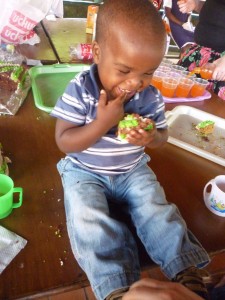By Reta Raymond
Associate Special Features Editor
After writing about some of the brighter aspects about Ugandan culture in my last note, I want to continue this trend for one more week and share my notes on a favorite topic—Ugandan food!
My mother is a chef, so food has always been an important part of my life. I thought I’d write this article about the different foods that I encountered in Uganda through birthday parties, good-bye feasts, and daily lunches at the law firm. Generally, Ugandan cuisine is very carbohydrate heavy and a little bland, but I found my favorites quickly!

The one thing I learned from my mother is that you must eat other people’s cooking. In Uganda, I always felt as though I was under the microscope around mealtimes. Joel, the guesthouse manager, would cook dinners for us, which ranged from pancakes (our favorite) to cinnamon flavored meat stew (I would eat rice). When he found that someone wasn’t eating his food, he’d be angry and would rebut our protests of certain foods with, “I know what Muzungus like to eat!” So he would serve what he thought was the “Muzungu” (white people) version of Ugandan food. For example, Ugandans will typically eat rice, posho (a slightly sweet porridge/mashed potatoes equivalent), matoke (steamed mashed plantains), beans, and meat stew for one meal. Joel would translate this into rice, mashed potatoes, French fries, pasta, and fried chicken. There were always at least three different types of carbohydrates at every meal.
At the law firm, the whole firm would eat at the same time. We would all line up outside the kitchen down the hall and serve up traditional Ugandan food that was made by a former employee and brought in. It was pretty much the same meal, every day. Rice, beans, matoke, posho, beans, maybe some steamed bitter greens and meat stew. It was quite well made, and I always ate in for the social aspects of it, as well as to be polite. But I can’t lie: I haven’t eaten beans since the summer. However, I did find the posho to be kind of good, probably because I like sweet things and it had a vaguely sweet taste. After reading up on the nutritional content online, my eyes nearly popped out of my head. Posho is a food that is used to rehabilitate starving people, as it has nearly 300 calories per half cup. A 300-calorie serving goes a long way for a short girl that sits in an office all day.
One weekend I ended up spending the day at my friends’ goodbye “dinner” at their bosses’ modest middle-class home in a suburb of Kampala. It turned out to be an eight-hour feast with nearly two-dozen different dishes served. The boss’ girlfriend and his sister served and prepared the food, kneeling to the men when they were serving them. The women stayed in the kitchen nearly the entire visit. We were asked to be there at noon, but didn’t eat until at least six. In addition to the already mentioned typical Ugandan foods, there was also chapatti (a thin spongy pancake-like bread, similar to Ethiopian injera) and many different types of stews and steamed, starch vegetables wrapped in banana leaves. They also served plates of spaghetti noodles for a Muzungu carbohydrate, and then there was Ugandan spiced cake and brandy at the end. It was a feast for ten Ugandan kings and three Muzungu girls.
I would also attend parties at the babies home (a Ugandan orphanage for children under four-years-old) next door to my guesthouse. These usually occurred when the children were baptized or if one was leaving because they had been adopted. The typical party would involve soda for the children (I was astonished that children under four-years-old were given soda), samosas, and a Ugandan spiced cake, which is similar to carrot cake. Drum playing, singing, and dancing would eventually follow with the caffeine and sugar rushes.

I cannot say that I was the biggest fan of most Ugandan food, except for chapatti and posho. I was always a little afraid of the meat—the meat shops on the street smelled like death—but I did enjoy the experience of trying these new and different foods, even if they didn’t end up being my favorite. And even when I couldn’t communicate well with a particular host or their family, and regardless of where I was in Uganda, it did make people happy to see that the silly Muzungu girl was eager to try the local food.
In retrospect, I guess I could have survived off trail mix, beef jerky, and peanut butter from America, like one of my housemates did. However, the irony was that she got the stomach flu, and I, who always ate the food, never got sick!